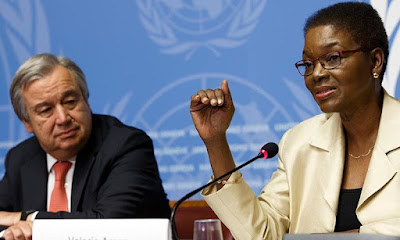UN and Disaster Preparedness
Al-Bab Report
8th October 2016: Pakistan has shown immense resilience in the face of devastating natural disasters and crippling emergencies, time and time again. Today, we are eleven years from the horrible earthquake in 2005 that took thousands of lives; it turned several towns and villages in Northern Pakistan into graveyards with thousands buried under rubble – very many of them children. The Government of Pakistan has declared that tragic day, 8th October, as the National Disaster Awareness Day to sensitize communities to learn from disasters and play their role as socially responsible citizens.
Dealing with a calamity of such magnitude would overwhelm any country. But it was made more difficult because of the lack of strategic Disaster Risk Reduction (DRR) planning and management. Public buildings, notably schools and hospitals were not built to reduce the risks from an earthquake. Roads were not engineered to withstand an earthquake and capacities and procedures were not in place for rapid response. Houses, especially those of the poor, were especially vulnerable to their roofs collapsing.
Pakistan has learned lessons from that experience and is applying those to reduce the considerable risks it faces from earthquakes, floods, droughts, landslides, climate change and man-made crises. The effects of disasters on people, society and the economy can accentuate poverty and social exclusion, especially if preparedness planning does not take this into account. The UN is committed to helping Pakistan weather these storms – offering immediate relief, strengthening preparedness and enhancing capacities to rebound from disasters. By helping Governments to identify dangers and how to overcome them, the UN is working to help Pakistan be better prepared to withstand disasters.
By building the capacity of a host of actors – communities, state officials and implementing partners – through training on Disaster Risk Reduction, we equip them to better handle catastrophes. Provincial governments demonstrated their capacity to respond to ad hoc emergencies in their coordinated response to earthquakes in northern Pakistan in late 2015 and the year before in Baluchistan.
Through effective risk assessment and hazard mapping- which is now firmly in place in KP- a Provincial Government is implementing cohesive disaster risk management policies, coordination and oversight mechanisms. This allows us to do our part in ensuring that if calamity strikes, we would be able to overcome it.
Just last year, 45,900 households were assisted by DRR initiatives in areas beset by drought and floods in Sindh and KP, including via conditional cash transfers of US$ 6.59 million. Preparedness centered on water management in Sindh’s drought-ridden district of Tharparkar: 240 household water storage tanks and 6 community water harvesting structures were built – capable of storing 1.2 million litres of water, enough to meet the needs of 20-25 households for 4 months – complemented by training on livestock management, nutrition and hygiene.
With UN support, the National Disaster Management Authority (NDMA) developed a National “Multi Hazard Vulnerability Risk Assessment Policy” and a “National Disaster Management Implementation Road Map” for Multi-Hazard Vulnerability Risk Assessments, Community-Based Disaster Management and Capacity Building (2016-2030), with guidelines for vulnerable districts. Advocacy is driving its implementation across Pakistan. Multi hazard, cross-sectoral Emergency Preparedness and Response Plans have been created for FATA and all four provinces, evoking a host of contingency agreements. Contingency supplies are in place for 100,000 people.
The Pakistan UN team has worked with NDMA to support households in flood- and earthquake-affected areas to rebuild safer, disaster-resistant shelters through conditional cash-based interventions, coupled with technical and monitoring attentiveness. To help communities “build back better”, a Construction Guide has been designed to optimise recovery shelter programmes. This Guide places environmental management at its core, outlining innovative techniques like dynamic thermal modelling, energy efficiency, air quality and daylight analysis.
Similarly, the Emergency Services (PLaCES) model offers child protection, education, recreation and community engagement in emergencies, addressing the needs of girls, boys, women, men, the elderly and persons with disabilities. To build community capacity, 14,000 multilingual Disaster Risk Reduction Resource Kits raised awareness, including storybooks and animated Videos for 2.8 million children, last year.
The UN has a responsibility to safeguard communities from environmental hazards by building long-term resilience through integrated recovery programming, in collaboration with the government. We strive to always do our best to reduce risk in a place that is one of the ten countries in the world most affected by climate change and natural disasters. If the lessons Pakistan has learned from the 8 October 2005 can be applied to all of the country, progress towards the SDGs will be met. If not, coming disasters may derail development.



No comments:
Post a Comment